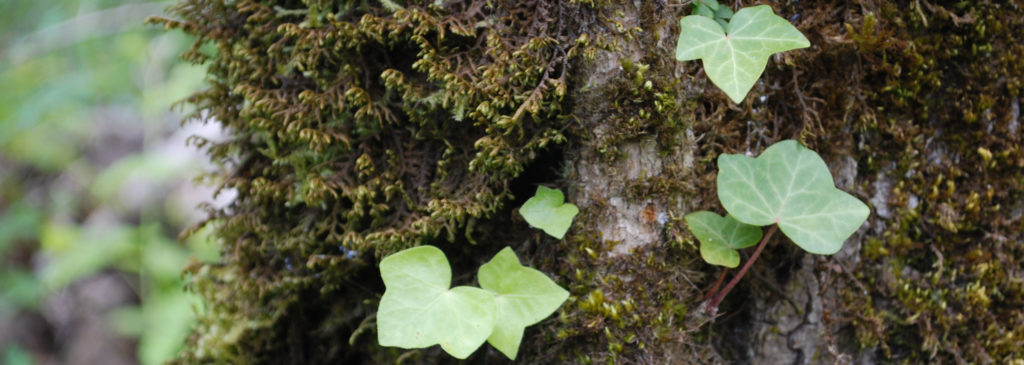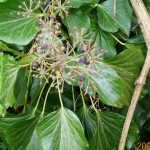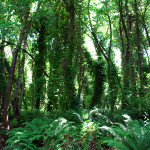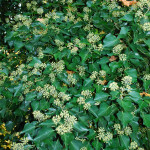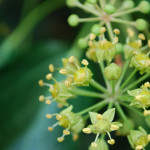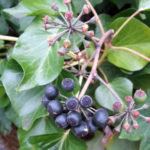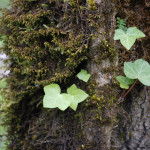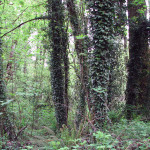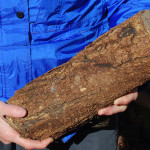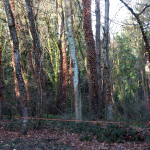Common names:
English Ivy
Atlantic ivy or Irish ivy
Scientific Name:
Hedera helix (syns. Hedera helix ssp. helix, Hedera canariensis, Hedera helix ssp. canariensis)
Hedera hibernica (syns. Hedera helix ssp. hibernica)
Noxious Weed Listing:
- WeedWise: Maintenance
- State of Oregon: Class B
- State of Washington: Class C
- 4-County CWMA: Class C
- Columbia Gorge CWMA: Class B
Description:
General:
English ivy is an evergreen climbing vine in the Araliaceae (Ginseng) family. It has historically been a common garden ornamental and has more than 400 cultivars. It has escaped cultivation to become highly invasive in forests and natural areas throughout the Pacific Northwest. Native to Europe, these plants are characterized by long viny stems reaching up to 30 m in length, with aerial, clinging small roots. English ivy damages desirable vegetation by shading out and smothering plants. English ivy also covers trees making them more susceptible to wind damage due to the additional weight of the ivy in the trees as well as the additional drag of the evergreen leafy vines. English ivy has two distinct growth forms: a juvenile form, that is characterized by rapid clonal and vegetative growth, and a mature form characterized by flowering and berry production.
In Oregon, three Hedera species have been documented: English ivy (H. helix), Atlantic ivy (H. hibernica), and Persian ivy (H. colchica). However, only H. helix and H. hibernica are listed as noxious weeds in Oregon. The invasive plant commonly referred to as English ivy is actually comprised of both H. helix and H. hibernica. Identification and differentiation between the species are complicated because of there many cultivated varieties. Both H. helix and H. hibernica have been commonly sold as English ivy, but can be differentiated by leaf shape and tiny hairs on the young leaves. These two species can also be differentiated through genetic testing.
Leaves:
The leaves come in two forms: juvenile and mature. Both leaves are evergreen, leathery, and palmately shaped. Juvenile leaves have 3-5 lobes and are slightly hairy. Generally, the lobes on H. helix are deeper than H. hibernica, but the lobes can vary. The leaves of mature ivy are ovate to diamond-shaped, unlobed or slightly lobed, darker green and more leathery. On both growth forms, the leaves alternate along the vines and are up to 10 cm long. Leaves can be toxic to humans and cattle if ingested. Leaves can also cause contact dermatitis in sensitive individuals.
Flowers
English ivy generally will only flower under conditions with adequate light and optimal nutrients. Flowers are only produced high in the tree canopy within infested forests, or along steep slopes. English ivy flowers in the fall and are pollinated by insects. Adult plants flower in clusters. The flowers are five-petaled, greenish to white in coloration and are only 3-5 mm long.
Fruits
Fruits develop as fleshy, dark blue to black berries that ripen in spring. Thousands of fruits can be produced by an adult plant each year. English ivy berries, particularly when underdeveloped, can be toxic to humans and cattle if ingested. These fruits are 5-10 mm in size and hold 1-3 seeds. Approximately 70% of the seeds produced are viable.
Roots
The juvenile English ivy plants have adventitious roots at their nodes. Roots are generally shallowly rooted, but robust. English ivy also forms aerial, clinging rootlets, allowing it to adhere and climb vertically. Adult English ivy plants form a woody base.
Reproduction:
English ivy reproduces both from mature seeds as well as from root-like stems and sprouting fragments. The berries of English ivy are ingested by birds and the seeds can be dispersed great distances from parent plants. New plants can regenerate from stems and fragments from both the mature and juvenile growth forms. Regenerating plants maintain the growth form of their parents, such that plants formed from stem regeneration of adult form plants will keep adult characteristics. Once established juvenile plants can live up to 10 years before reaching maturation. English ivy plants can live up to 100 years or longer with one plant in England being documented at more than 400 years in age.
Habitat:
The areas most infested by English ivy are urban natural areas, disturbed forests, woodlands, and along stream corridors. Plants grown in moist soils with summer shade and winter sunlight will flourish. Urban forest and natural areas are especially impacted as a result of repeated reinfestation from garden escapees.
Impacts:
- Weighs down and harms large canopy trees making them more susceptible to wind throw
- Smothers and displaces forest floor vegetation.
- Degrades wildlife habit and reduces the diversity of animals in infested areas.
- Toxic berries and leaves can cause injury.
- Very invasive with rapid and intense vegetative growth, that can quickly transform a site.
- Seeds disperse great distances, making containment of infestations very difficult.
- Can be a reservoir for bacterial leaf scorch harmful to elms, oaks, and maples.
- Vines tangle among native understory making removal difficult.
- Increases erosion due to the displacement of native species and a shallow root system.
Introduction:
The original introduction of English ivy to the United States is believed to have been by European immigrants during colonial times as a garden ornamental. The earliest record of English ivy in North America dates to 1727. Introduction to the Portland area occurred between 1875 and 1899 (Christy et al., 2009).
Distribution:
Clackamas County:
English ivy can be found throughout Clackamas County. It is very widespread and directly impacts properties throughout the county. As a ubiquitous weed, this is not a species that is actively surveyed and the mapped distributions do not represent the full extent of the English ivy population in Clackamas County.
State of Oregon:
United States:
Management:
Strategy:
The management of invasive weeds is best served through a process known as Integrated Pest Management (IPM). IPM is a weed management methodology that utilizes:
- Management thresholds to determine when and if to initiate control,
- The ecology and life history characteristics of the targeted invasive weed,
- Site-specific conditions and land use considerations to inform management practices,
- The effectiveness and efficiency of various control methods.
An IPM based strategy ensures the maximum effectiveness of treatment measures. IPM strategies typically use more than one management method to target one or more susceptible life stages. It should be adaptive to site conditions in the field and to the response of a plant to management. The utilization of multiple management tools inherently reduces the use of herbicides in a management plan. The IPM process ultimately provides a framework for the establishment of Best Management Practices (BMP) which outlines the best approach for controlling a weed particular infestation.
Manual:
English ivy is often best controlled using manual control methods. The waxy leaves of English ivy and its ability to regenerate from stems and fragments, make it resistant to chemical and mechanical control methods. While effective the removal of English ivy can be time-consuming and labor-intensive. As such, persistence is possibly the most important factor in determining the success of your treatments. It has been suggested that an acre of English ivy dominated forest requires more than 300 man-hours for an initial clearing and continued maintenance to restore a site. So restoration efforts should plant their work accordingly
The first step is to choose an area, that can receive repeated control efforts. Prioritize your site. Choose a portion of your management area that is of highest priority, or work from a relatively intact area, and slowly expand your treatments systematically outward. Look at the concentration and location of the ivy, the landscape, soil moisture, abundance of native plants in the area as well as the number and skill of workers assisting. Before handling English ivy be sure to wear long sleeves, long pants, and gloves to protect yourself from potential dermatitis. Utilize tools such as shovels, rakes, mattocks, and weed wrenches to assist in the removal of the roots. Saws, loppers, and hand clippers can be used to cut vines.
In locations where native plants are abundant, the preferred practice is hand removal. Vines growing on trees should be targeted first to prevent flowering and seed set and to preserve canopy trees on site. Vines on trees should be cut using a saw, loppers or hand clippers around the entire base of the tree and also at a comfortable arm reach then removed from the tree. Leave the remaining ivy above the cut line to dry out and fall down on its own. All ivy should be removed within, a minimum of 3 feet around the trunk to better protect the tree. Flowering or seeding plants should be removed to prevent seeding or regeneration. For ground ivy control should focus on one location, pulling every vine and root up within reaching distance, before moving to a new location. Working systematically from a core area. Manual control of English ivy is best done in the fall and winter when the ground is soft and plants are not seeding.
When few native plants reside on the property and there are sufficient workers, English ivy can be removed in large mats using a technique called the ‘Log Roll’. This technique relies upon first defining a treatment area. The perimeter of the area is cut and a line of workers pull the edge of the mat, rolling vines and roots of the ivy on top of itself. It is important to shake the roots to remove soil. The roll should then be mulched in place to prevent resprouting. Workers should also follow up in the cleared site to remove any missed roots. This practice can be done on both flat ground and on hillsides. Soils with higher water content allow for an easier pull.
Additional tips to reduce erosion and minimize damage to native plants:
- Remove as much of the root system as possible by pulling the vine directly where the root comes out of the ground
- Minimize trampling and churning of the soil
- Protect native plants that are present through careful and conscientious pulling and walking
- Be thorough, by completely clearing an area before moving on
Mechanical:
English ivy can be mowed or cut but this is generally not recommended due to its ability to regenerate following cutting.
Cultural:
Grazing has been used to defoliate large infestations of English ivy. Goats and sheep will graze the ivy leaves, but plants will readily resprout following grazing. As such, grazing animals must be rotated repeatedly back onsite to suppress regrowth. English ivy is generally not favored by grazing animals, so co-occurring native plants are usually grazed more strongly than the ivy itself. As such, grazing is generally considered to be ineffective, or of limited use. Mature ivy plants are also generally found growing above the browse line, so manual removal of tree ivy is required in conjunction with any grazing strategy.
English ivy is fire resistant and doesn’t carry a fire well. The repeated torching of ivy plants will cause cellular damage and dieback. With persistence, this method will exhaust nutrients as the English ivy resprouts, but it is generally inefficient compared to other methods. As such this method is generally not recommended.
Chemical:
Effective chemical control of English ivy is dependent on a few variables including timing, sensible application, and the proper mixture of chemicals. The timing is important to limit damage to native plants. Herbicide application during dry and sunny periods in late winter can be an effective chemical control on English ivy. The ivy is still alive and may still be growing in the winter while most native plants are dormant and protected. Herbicide has shown to be successful when applied directly to cut stems specifically around a tree trunk.
Foliar application of herbicides is deterred by the waxy coating on the leaves. This is especially true for older/mature leaves and application during the growing season. This leads to runoff of herbicide onto nearby native plants. A fatty acid can be applied before or with the herbicide application to increase absorption into the leaves.
Widespread chemical control of English ivy is not suggested and should only to be considered in areas completely dominated by ivy or on difficult sites were manual control methods may be impractical or dangerous.
Before you Start:
- Before purchasing any herbicide product it is important to read the label. The label is the Law. Carefully review all parts of the label even if you have used the product before. Select a product that is most appropriate for your site. If you have questions, ask your vendor before purchasing a product.
- When selecting herbicides always use a product appropriately labeled for your site. Follow label recommendations and restrictions at all times. If any information provided here contradicts the label, the label takes precedence. Always follow the label!
- Protect yourself. Always wear the recommended protective clothing identified on your label and shower after use.
- When applying herbicides use spot spray techniques whenever possible to avoid harming non-target plants.
- Do not apply during windy or breezy conditions that may result in drift to non-target plants
- Avoid spraying near water. Hand-pull in these areas, to protect aquatic and riparian plants and wildlife.
- Avoid exposure to pets, pollinators, and wildlife. Remove animals from treatment areas to avoid exposure to herbicides. Follow the reentry instructions on your herbicide label and keep pets out of the area until the herbicides have dried and it is safe to return. Avoid spraying when insects and animals are active. Avoid spraying blooming plants to minimize any effects on bees and other pollinators.
- Be sure to store any chemicals out of the reach of children and pets to keep your family safe.
- Product labels and formulations change regularly. Check the Pacific Northwest Weed Management Handbook and the label for current control recommendations.
Herbicides:
The mention of any brand name product is not, and should not be construed as an endorsement for that product. They are included here only for educational purposes. Suggested rates are generalized by active ingredient. Specific rates will vary between products. Be sure to review the label before application and use the recommended label rate at all times.
Active Ingredients
Product Names: Accord, Aquamaster, Rodeo, Roundup, and various others
Rate:
Spot treat: use 2% to 5% v/v solution in water, with a non-ionic surfactant
Low volume/thin line: 10% v/v solutions in water.
Cut stump: 25% v/v solutions in water.
Time: Apply when actively growing in late summer early fall. An application can also be made on sunny winter days to avoid harming co-occurring natives. Cut stump applications should be made directly after cutting and during the dormant season for best results.
Comments: Wait four months after foliar treatment before cutting again. For cut stump application, cut stems horizontally or at ground level. Apply the solution directly after the cut. Treatment controls most resprouts. Glyphosate is not selective and will harm grasses. Use care when working around desirable plants to avoid damage. Leaves should be sprayed until wet but not dripping to achieve good control.
Product Names: Garlon 3A, Garlon 4 Ultra (triclopyr ester), Pathfinder II
Rate:
Spot treat: 2 to 5% v/v solution in water with a non-ionic surfactant.
Low volume/thin line: 10% v/v solution plus 20% basal oil concentrate in water.
Cut stump: 20% v/v solution in water.
Time: Apply post emergence in late summer to early fall, (August – October) when plants are growing rapidly. Cut stump applications should be made directly after a cut and during the dormant season for best results.
Comments: For cut stem treatment, follow the application description in Glyphosate. Triclopyr is selective and will harm desirable broad-leaf plants, trees, and shrubs. Use care when working around desirable plants to avoid damage. Leaves should be sprayed until wet but not dripping to achieve good control. Triclopyr ester formulations may volatilize under warm temperatures.
Product Names: Tordon 22K
Rate:
Broadcast: 3-4 pints/acre (0.75 to 1 lb a.e/acre) plus .25 to .5% v/v surfactant
Time: Apply postemergence in late summer to early fall, (August – October) when plants are growing rapidly at or beyond early to full bloom stage.
Comments: Picloram can have long-term soil activity and has shown to move with groundwater. It should not be used around trees because of root uptake. Use care when working around desirable plants to avoid damage. Leaves should be sprayed until wet but not dripping to achieve good control. Restricted herbicide.
Product Names: Arsenal, Habitat, Stalker, Chopper, Polaris
Rate:
Spot treat: 1 to 2% v/v solution plus .25 to .5% surfactant v/v in water.
Low volume/thin line: 10% v/v solution plus 20% ethylated crop oil in water.
Cut stump: 20% v/v solution in water plus 20% ethylated crop oil in water.
Time: Apply post emergence in late summer to early fall when the plant is growing rapidly.
Comments: Imazapyr exhibits some residual effects in the soil and may result in bare ground around plants after treatment. Care should be taken when replanting. Cut stump applications should be made directly after cutting and during the dormant season for best results.
Product Names: Tank Mixed
Rate:
Spot treat: 4% v/v Glyphosate solution + 2% v/v Triclopyr solution, with 1-2% non-ionic surfactant v/v in water.
Time: Apply in late summer with a late fall follow up.
Comments: Treat when temperatures are above 65 F when no rain is expected for 2-3 days.
Biological:
There are no effective biological control agents available for English ivy.
Disposal:
There are many ways to dispose of English ivy when clearing your property. For small infestations, bagging up pulled plants is the best practice if possible. For larger infestations, pile up the debris and let it dry out. Placing a tarp under the pile will help prevent resprouting. Piles can also be covered to speed up drying and decompositions. Large debris piles can create dead spots, so placement of piles should be placed to minimize the impact to desirable vegetation. Under dry conditions, plants can be chopped into a mulch and spread over the area for ground cover and nutrients, but be careful with this method as covering the ground will reduce the visibility of missed/live roots.
Follow-Up:
Diligence is the most important aspect of controlling English Ivy. Ivy plants will readily resprout from any roots left remaining, so repeated follow-up is required. An herbicide application in summer has shown to be the most effective after treatment. Re-treatment may be required to achieve effective control. The seed may persist in the soil for years following treatment or arrive on-site from adjacent and nearby infestations.
Best Management Practices:
Monoculture Infestations:
- Consider the land use practices on site. Identify, any site-specific considerations that should be taken into account before initiating control.
- Be sure you can properly identify English ivy. If you are unsure about your weed bring a sample to the Conservation District, and we can help to identify your particular weed.
- Identify any native or desirable plants nearby, and take precautions to minimize any negative impact on them.
- Herbicide application is often the best approach with respect to cost, time, and erosion protection for large ivy infestations with few desirable plants.
- Winter applications have shown to be effective while minimizing the impact to native, but spray only during when winter weather is above 55 F, and no precipitation is expected for at least three days. Otherwise, plan treatments for late summer.
- Follow-up treatments 6-12 months afterward can be as re-treatment of herbicide, spot spray herbicide application or spot manual removal.
- Replant site with site-appropriate native vegetation as soon as possible. Grass seed can be spread to stabilize soil in between removal and plantings.
- Continue to monitor the site for regrowth and treat any new infestations.
Small Infestations within native or desirable vegetation:
- Consider the land use practices on site. Identify, any site-specific considerations that should be taken into account before initiating control.
- Be sure you can properly identify English ivy. If you are unsure about your weed bring a sample to the Conservation District, and we can help to identify your particular weed.
- Identify any native or desirable plants nearby, and take precautions to minimize any negative impact on them.
- A manual approach is best with a limited spot spray application of herbicide in dense patches within native vegetation.
- Pull plants in winter and spring when the soil is moist and the ivy is prominent.
- Replanting is not as necessary in small infestations within native vegetation because the natives will expand into open areas. If large gaps are present, additional plantings may be beneficial.
- Continue to monitor the site for regrowth and treat any new infestations as they occur.
Fun Facts:
- Juvenile plants can climb as much as 30 ft per year.
- Leaves and berries have been eaten as an expectorant.
- A leaf reduction can be used to restore dark fabrics or dye hair and twigs can create yellow and brown dye.
- Medicinally used since ancient times to treat rheumatism, toothache, bronchitis, and many skin problems including burns, infections, and cellulite.
- Ivy has been long used in England as decorations during the Christmas season.
Gallery:
- English ivy
- Tree ivy infestation
- English Ivy
- English ivy flowers
- English ivy berries
- English Ivy seedling
- English ivy in trees
- Massive English Ivy Stem
- English ivy after treatment
Additional Information:
- Oregon Department of Agriculture: English ivy
- English ivy is an invasive weed in the Pacific Northwest
- Oregon State University Extension: Invasive Weed in Forest Land: English ivy
- Controlling English ivy in the Pacific Northwest
- Pacific Northwest Weed Management Handbook: English ivy
- King County Washington: English ivy Weed Bulletin
- Center for Invasive Species and Ecosystem Health
- No Ivy League
- Weed Research & Information Center: English Ivy Weed Report
- Invasive Species Compendium: English Ivy Datasheet
References:
- Bossard, C. C., J. M. Randall, & M.C. Hoshovsky. 2000. Invasive Plants of California’s Wildlands. Berkeley, CA: University of California Press. pp 277-281.
- Christy, J. A., A. Kimpo, V. Marttala, P. K. Gaddis, & N. L. Christy. 2009. Urbanizing Flora of Portland Oregon 1806-2008. Native Plant Society of Oregon Occasional Paper 3 pg. 218.
- DiTomaso, J.M. & E.A. Healy. 2007. Weeds of California and Other Western State vol 2. University of California ANR. pp 1426-1434.
- DiTomaso, J.M., G.B. Kyser, S.R. Oneto, R. G. Wilson, S. B. Orloff, L. W. Anderson, S. D. Wright, J.A. Roncoroni, T.L. Miller, T.S. Prather. 2013. Weed Control in Natural Areas in the Western United States. Davis, CA: UC Weed Research and Information Center. pp 341-343.
- Holloran, P., A. Mackenzie, S Farrell, D. Johnson. 2004. The Weed Workers Handbook: A Guide to Techniques for Removing Bay Area Invasive Plants. Berkeley, CA: California Invasive Plant Council. pp 60-61
- Kaufman, S. R. & W. Kaufman. 2007. Invasive Plants: Guide to identification and the Impacts and Control of Common North American Species. Mechanicsburg, PA: Stackpole Books. pp 145-151
- King County Noxious Weed Control Program. 2011. English ivy identification (Hedera helix). https://www.kingcounty.gov/environment/animalsAndPlants/noxious-weeds/weed-identification/english-ivy.aspx (Retrieved Jan 21, 2014).
- Oregon Flora Project. 2013. Oregon Plant Atlas: Hedera helix. http://www.oregonflora.org/atlas.php. (Retrieved Jan 21, 2014)
- Peachy, E., D. Ball, A. Hulting, T. Miller, D. Morishita, P. Hutchinson. eds. 2013. Pacific Northwest Weed Management Handbook: Control of Problem Weeds. (Retrieved Jany 21, 2014).
- Soll, J. 2004. Controlling English Ivy (Hedera helix) in the Pacific Northwest. The Nature Conservancy. https://www.invasive.org/gist/moredocs/hedhel02.pdf (Retrieved Jan 21, 2014)

